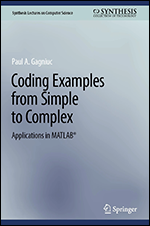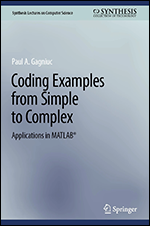Visual Basic and Visual Basic .NET for Scientists and Engineers
- 4h 57m
- Christopher M. Frenz
- Apress
- 2002
- Covers how Visual Basic .NET can be harnessed to meet the needs of scientists and engineers
- Shows how to use VB and VB .NET to solve classic algorithms that are relevant to real-world scientific environments
- Shows readers how to program nontrivial applications, and provides examples of how to craft professional-looking GUIs for scientific graphics and data presentation
Visual Basic and Visual Basic .NET for Scientist and Engineers begins with an overview of the Visual Basic and Visual Basic .NET IDEs, their important characteristics, and how the development environments can be manipulated to suit developers’ needs. After a solid discussion of VB and VB .NET forms, controls, and namespaces, Christopher Frenz shows readers how to put controls to work by making use of the different control events.
Once this introductory material has been covered, readers are introduced to the different data types that Visual Basic supports, with special attention paid to the various numerical data types and their uses. Frenz then takes an in-depth look at the various numerical and logical operators and their precedence. Readers explore VB’s loop structures via practical examples.
Frenz later delves into topics such as designing GUI’s programming, customized spreadsheets, and debugging. Along the way, readers learn about the all-important file handling and data acquisition techniques, as well as how to graphically display their data. Readers are also introduced to more advanced topics, including mathematical modeling, and to the new, rapidly growing field of bioinformatics.
About the Author
Christopher M. Frenz is currently a graduate student in biochemistry at the Albert Einstein College of Medicine, where he uses artificial neural networks to model biological systems. He holds degrees in biology and chemical engineering from Manhattan College and has over 10 years of programming experience. In addition to Visual Basic, he’s also proficient in FORTRAN and Pascal, and he contributing editor to the journal Inside Visual Basic.
In this Book
-
Overview of Visual Basic Programming and the Visual Basic Development Environment
-
Working with WinForms
-
Controls and Their Uses
-
Variables, Data Types, and Operators
-
Arrays and Loop Structures
-
Built-in Functions
-
Writing Your Own Functions and Procedures
-
Getting Data from External Sources
-
Programming Your Own Spreadsheets
-
Scientific Graphics
-
Debugging and Error Handling
-
Packaging and Deploying Your Application
-
Mathematical Modeling
-
Bioinformatics
-
Web-Based Applications




